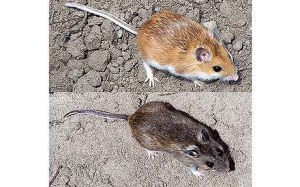 I’ve just come across an interesting evolution item in the news. A North American mouse species has changed its fur colour from brown to blonde in a mere 8,000 years. It is a very fine opportunity to understand natural selection at work.
I’ve just come across an interesting evolution item in the news. A North American mouse species has changed its fur colour from brown to blonde in a mere 8,000 years. It is a very fine opportunity to understand natural selection at work.
Let’s consider a mammalian species that lives in an environment it has adapted to through the millennia. Let it be a mouse and let’s pick a particular trait – fur colour. When the mouse lives in an area where the soil is dark, it is advantageous to sport a dark fur in order to avoid predators. But if an ice age happens to occur and a glacier deposits sand (which is much lighter in colour) onto that particular area, then, all of a sudden, the dark brown pelage turns disadvantageous and counter-adaptive. What this means is that the brown mice against the yellow background are too conspicuous to evade the attention of predators. Now, if a random mutation occurs in the colour, say blonde, and it happens to be advantageous, natural selection will preserve it. How? Let’s say in a litter of eight mice, seven is brown and one is blonde. Only one gene regulates fur colour in mice, and the blonde allele (variant of the same gene) happens to be dominant. In a light-coloured environment, the one blonde mouse is hugely favoured with respect to camouflage as opposed to its brown siblings. All the browns are selected out, and the light-coloured individual has increased chances of survival, because it blends in the colour of the sand dunes. Then in a couple of generations (this means, of course, given the reproduction rate of mice, thousands of generations) the new colour will be fixed and the species will have adapted to its new environment.
It took about 8,000 years for the deer mouse (Peromyscus maniculatus) population of this area in Nebraska to gradually change from brown to blonde. How do we know they used to be brown? Deer mice of surrounding areas of darker soil all wear dark brown fur.